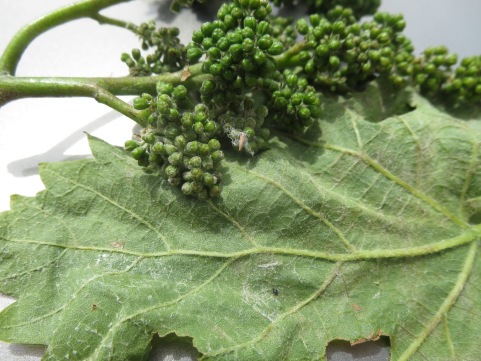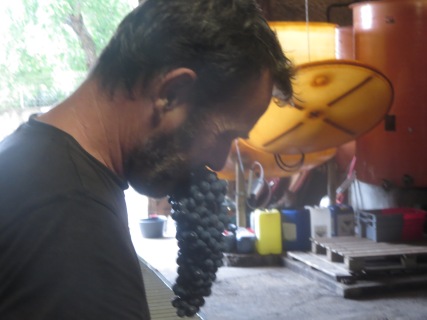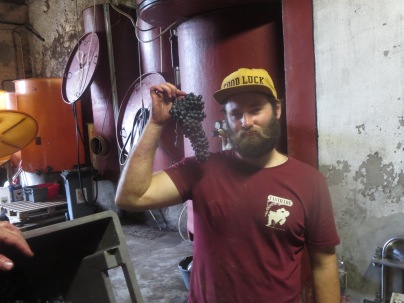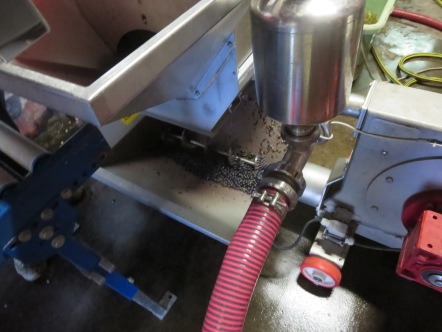There are numerous different tasks during the vendanges, I thought I’d expand on a few as I reflect on the last two days. Both Thursday and Friday began with lovely sunrises over the vines as we picked, almost worth the early start to the day.
Picking was done by the half dozen Moroccan workers who work non-stop and chatter away even faster. This year there was a more stable team working with Jeff, on previous vendanges there has been a core of people with lots of others coming to spend a couple of days and then moving on. Many of these did sterling work, such as Thomas and Charles, but with an unchanging team for three weeks progress has been smooth.
In the vineyard Julien and Vincent took charge along with Selene, Max, Roxane, Ambroise and Jeremy. Michel ferried the grapes to the cellar where Jeff controls the process of turning fruit into wine. The team (including myself) would also help out in the cellar as needed, Jeff aiming to give opportunities to learn about the winemaking process to everyone. Ever the teacher.

This photo shows Roxane, Selene and Max picking Carignan. Roxane is cutting the bunches whilst Selene and Max carefully sort through their bunches to remove anything untoward such as insects, leaves, rotten or dried berries. On the other side of the vines are other pickers to ensure everything is taken. The bunches go into buckets and when they are filled they are emptied into the cases stored under the vine.
Michel arrives in the vineyard and drives between two rows to collect the cases, often supported by Julien. The grapes are returned to the cellar as quickly as speed limits allow, unloaded and subjected to further sorting.
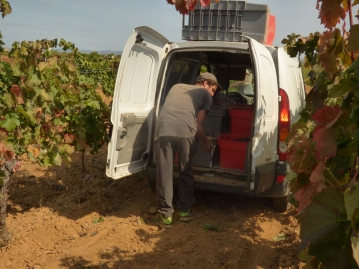
In the photo below Ambroise is checking for anything which escaped the pickers or fell into the cases whilst waiting to be collected. This year the grapes have been very healthy and so no need for the sorting table to be used. However, snails often sneak into the bunches and cases seeking some nourishment in the very dry weather.

The bunches are either pressed immediately, eg for white wine or sent to vat. In the latter case they will be destemmed first or sent as whole bunches depending on the style of wine Jeff decided will be most suited to the grapes. They will spend a day or two there before the process of debourbing or délestage. The juice has now been sitting on the skins, flesh and pips which form a cap on the top of the juice or sink to the bottom of the vat. Délestage involves removing the juice from this mass when it has absorbed as much colour, flavour, tannin as Jeff deems optimal. The juice heads to a new tank to recover. In the video below you will see that it passes through a machine which cools down the juice. Fermentation produces a lot of heat, too much can bring problems which would spoil the wine. That is the main reason why Jeff also invested in new temperature controlled stainless steel tanks this year, especially for white wines.
The fermentation begins promptly, the healthy yeasts produced by the grapes themselves triggers the process of turning grape juice and its sugars into alcoholic wine. Odours of bread making and fresh fruits fill the cellar, hints of the pleasures of Mas Coutelou 2017 wines ahead.

Skins after pressing
Meanwhile, after pressing the grapes skins are recovered from the press itself and put into a large container. There they will ferment and produce the base for brandy and spirits, nothing is wasted.
More interesting varieties were harvested these two days. Top left above is Muscat D’Alexandrie, large oval grapes tasting of pure grape juice. Carignan Blanc is one of my favourite white grapes from the region, it makes dry, complex wines. The middle row shows Carignan and Cinsault picked these days. Last but certainly not least, Castets is a rare red variety, less than 1 hectare in the world and much of that is in Peilhan. Sadly, it too has been hit by the dry summer, lovely quality but lacking in volume, a summary of this vintage.
And, after a hard day for some of us my T shirt shows the fruit of the day. Whilst Icare takes things at his own pace.



















